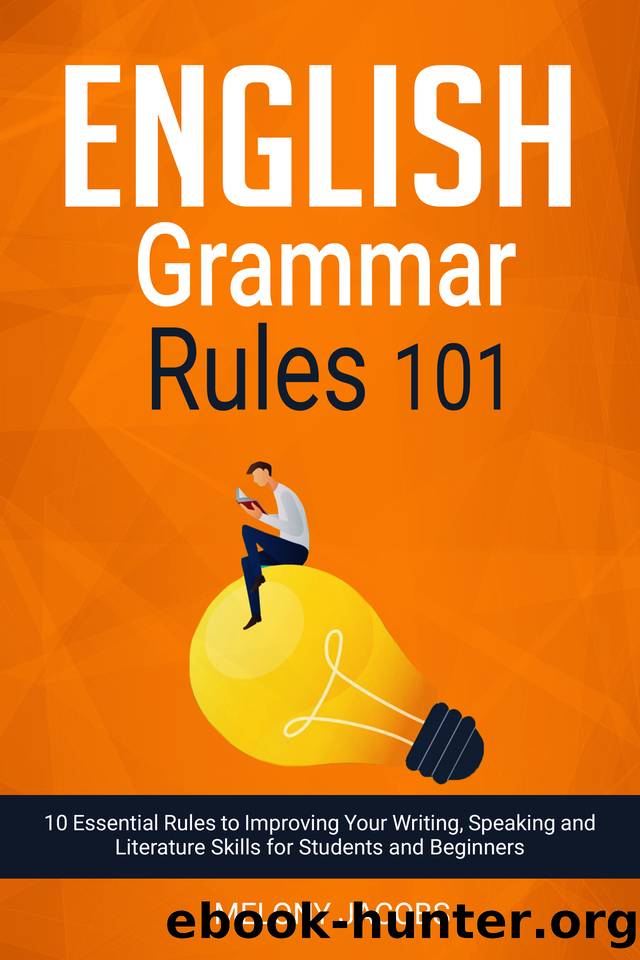English Grammar Rules 101: 10 Essential Rules to Improving Your Writing, Speaking and Literature Skills for Students and Beginners by Jacobs Melony

Author:Jacobs, Melony [Jacobs, Melony]
Language: eng
Format: epub
Published: 2019-12-11T16:00:00+00:00
Know when to divide and conquer: understanding apostrophes
The apostrophe is a multitalented punctuation mark. It can own everything and cut you out of the deal in an instant. Confused, don’t worry. I will explain what I mean right now.
I am very excited for my sister’ s wedding.
First off let’s talk about owning it all. To do that you need an apostrophe as it is the most common method to show possession, meaning that you or someone else owns something. In the example above, the person is excited about going to their sister’ s wedding. We know it is the wedding of their sister because there is an ‘s after the word sister.
You will be pleased to know that in English, there is only one way to show that something is possessive and that is to add an ‘s. So as long as you add this, you won’t go too wrong.
I am very excited about my sister Jessica’ s wedding.
That being said, you may falter off track when trying to position the possessive when a few more words are added to the mix. In the above example, the possessive apostrophe has switched to the word Jessica and is no longer on the word sister. That is because it wouldn’t make sense to stay on the word sister as it would suggest that the sister owns Jessica rather than Jessica owning her wedding. If you get confused, say it out loud and you will probably catch the mistake. Concentrate on who owns who.
This isn’ t anything to do with you.
Now comes the taking everything away from you part - or rather, taking everything away from the words. The above example showcases apostrophes being used in contractions. As you have heard me say before, we love to speed up our language. This has resulted in us shortening two words into one and using a contraction apostrophe to fill in the gaps. The word isn’t is a contraction of is not.
There are lots of examples of contractions that we use regularly, such as don’t, you’re, hasn’t, I’d, etc. Despite using them frequently, we all have a tendency to mess them up a bit and put the apostrophe in the wrong place. More often than not the apostrophe is placed before the last letter replacing vowel sounds in the second word. Commonly, people place it between the two contracted words, for example, do’nt and would’nt. Remember, the apostrophe is meant to replace missing letters so in the case of don’t it is replacing the o in not.
There we are, it’ s finally time to leave.
The dog thinks its bed is the sofa.
As we wrap up apostrophes, it’s about time we solved the ultimate apostrophe mystery: what is the difference between it’s and its . You know that English is the language of exception and this is no exception, well, except it is an exception! When coming to deciding how to deal with the case of it’s and its , it was a bit tricky for grammar theorists.
Download
This site does not store any files on its server. We only index and link to content provided by other sites. Please contact the content providers to delete copyright contents if any and email us, we'll remove relevant links or contents immediately.
Eats, Shoots and Leaves by Lynne Truss(885)
Easy-to-Learn English Grammar and Punctuation, Part 1 of 2: A step-by-step guide for a strong English foundation by Maruf Sitara(860)
The English Grammar Workbook for Adults: A Self-Study Guide to Improve Functional Writing by Michael DiGiacomo(762)
Complete English Grammar Rules by Farlex International(743)
200 English Grammar Mistakes!: A Workbook of Common Grammar and Punctuation Errors with Examples, Exercises and Solutions So You Never Make Them Again by Jacobs Melony(676)
Actually, the Comma Goes Here: A Practical Guide to Punctuation by Cripps Lucy(673)
How to Write a Sentence: And How to Read One by Stanley Fish(629)
Don't Believe a Word: The Surprising Truth About Language by David Shariatmadari(627)
Collins Easy Learning Italian Grammar by Collins(620)
Collins Easy Learning French Verbs by Collins(590)
Collins Easy Learning Italian Verbs by Collins(588)
The Elements of Style by William Strunk & E. B. White & Roger Angell(523)
Murder Your Darlings by Roy Peter Clark(522)
Collins Easy Learning Spanish Grammar by Collins(516)
Collins Easy Learning German Grammar by Collins(514)
Word Savvy Handbook: Use the Right Word by Ragno Nancy(459)
The Grammar Bible by Strumpf Michael & Douglas Auriel(456)
The Glamour of Grammar: A Guide to the Magic and Mystery of Practical English by Roy Peter Clark(442)
Word Order in English Sentences by Williams Phil(417)
